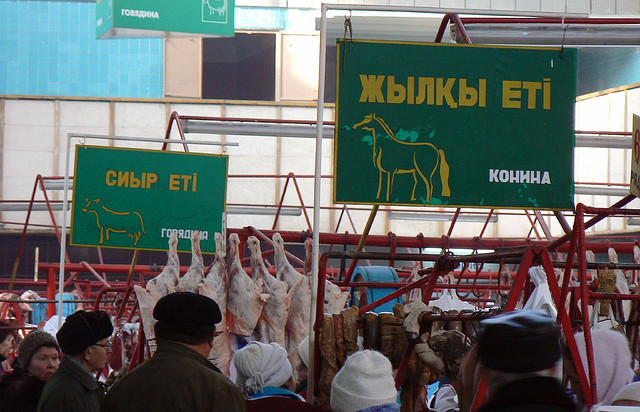Findus ready meals may not have reached Central Asia but there’s undeniably a very close alliance between man and beast in this vast tract of Central Asia.

A Kazakh nomads’ expression states, ‘Kazakhs are born on horseback’. If we take a leisurely canter from nomad life into the present day, we see the survival of horsemeat as a luxurious food in the Republic of Kazakhstan. Whilst on academic business there, I grasped the opportunity to pursue a sober study of this neglected subject. I visited two yamarka (outdoor markets) – one in Almaty, the former capital and largest city; the other 500km north in Stepnogorsk, a former closed Soviet town with notable levels of uranium, rare metals and gold.
Perhaps the best-known horse product from the steppes of Central Asia is kumis (fermented mare’s milk). In a restaurant in Astana I drank repeatedly from a palm-sized bowl of kumis. Once the sickly smell was put aside by application of my sensory self-discipline it tasted better and better, with a tang vaguely reminiscent of some highland malts.
So, what does horsemeat taste like? The extremely lean cuts are rich, dark and deep-red, slightly sweet, redolent of venison but much more tender. Because the horses are steppe reared, in what must be an original source of the term ‘free range’, there is little fat. In the great intestinal sausage the fat tastes like the richest butter.
At the rear of the market in Stepnogorsk, arranged in rows of wooden stalls, was the covered, refrigerated meat section. Through plastic cold doors there were about 40 stalls in a clean and chilly room. Only one sold horsemeat (and beef). The others sold beef, chicken, and mutton.
On their display table, amongst other meats, were four raw cuts arranged in a square – çürek (heart), baür (liver), kharim (stomach), and öpke (lungs). They also had Khazi (the main rib) and the mane, a beehive-shaped cross-section of meat and fat, both special delicacies. For the most respected guests there is an oval fillet from the chops, called omirtkIa. The oblong rump is called kesekyet, which means ‘meat to be divided’, and is used in bestirmek, the delicious preserved meat which is served sliced cold.
There were various sausages, ready for cooking, called shruzikI and kIarta (the small intestine, stuffed with chopped offal). And, of course, the great intestinal sausage (5-6cm diameter), where two thin strips of meat and fat are cut from the edge of the length of the rib cage and stuffed with crushed garlic, salt and pepper. A 60cm length is then tied off, cooked, and eaten cold. When I commented that not all parts of the horse were on display, they looked me in the eye and told me ‘we eat all of the horse!’
In the Green Bazaar in Almaty, the horsemeat was sold under a sign saying ‘Konina’, a separate part of the meat section of the market, which was as clean and spotless as Stepnogorsk. Each meat section displayed a small, tin flag, featuring a silhouette of the appropriate animal. I was reminded that Mareshchal Kutusov, after the battle of Borodino, repeatedly intoned that Napoleon’s army would be eating horseflesh in Russia before the winter of 1812 was out. He used the words loshadinoye miase, meaning beast-of-burden, as opposed to konili, meaning noble steed.
If the Kazakhs had known that horsemeat was so readily available in the UK, they might not have had it specially imported for their athletes during the 2012 London Olympics. For those wishing to rush out to their nearest Kazakh market and stock up on the real deal (or at least something advertised as what it actually is), a one- to two-year-old horse of 150-160 kg (dead weight) is slightly less expensive than the five-year-old horse 280 kg (dead weight), which is considered the better meat. In Almaty they said that a nine-month colt tasted even better. Like spring lamb or sucking pig, I suppose.
Robert Chenciner has recently published Dragons, Padlocks and Tamerlane’s Balls (Bennet and Bloom, 2013. Price £50), a material-cultural memoir of textiles, art, metals and myths.